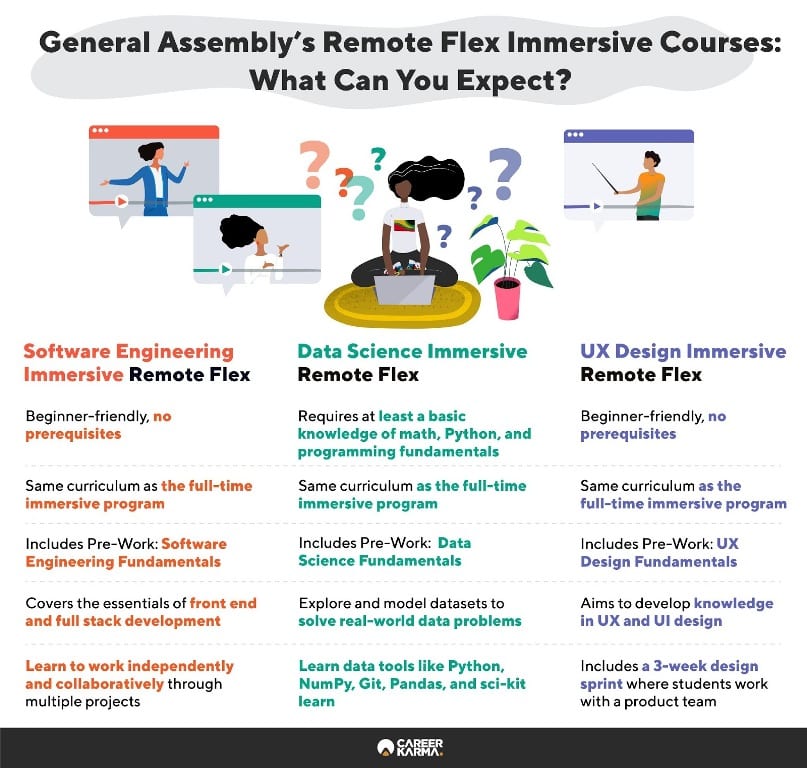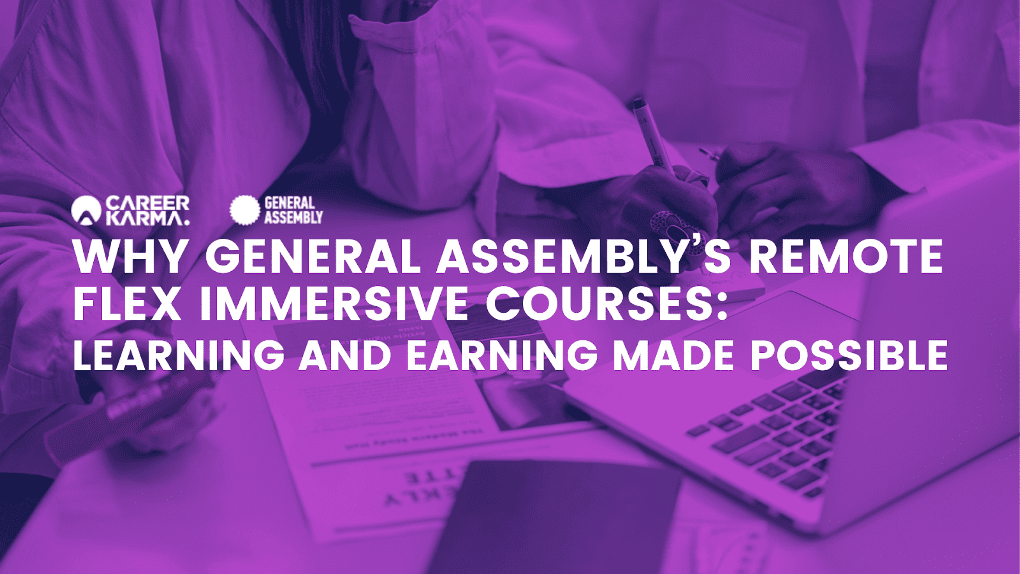After leaving behind a 10-year career in art education, Leanne Frisinger spent six months chasing after what she considered another artistic pursuit, with code as the chosen medium of expression: software engineering.
“When I was teaching in South Africa, I originally came on as the visual arts teacher,” said Leanne. “Then, I took over as the head of the visual arts and design department. All of a sudden, I had to level up quickly on a lot of modern design concepts…I had students combining art with programming, and I didn’t know anything about the latter at all.”
“At the time, I thought, ‘I just want to be in a position where I know more than what I know now.’”
Years later, Leanne enrolled in the coding bootcamp, General Assembly.
Non-Traditional Students Means Non-Traditional Needs
“It was more fortuitous than deliberate,” said Leanne, when asked about her decision to learn software engineering.
“When I moved to the United States, I initially planned on doing a UX design course. So, I signed up for General Assembly’s UX Design Immersive. I did all the pre-work and then, COVID-19 happened.”
The onset of the pandemic created a domino effect on Leanne’s plans. “Childcare facilities closed, and my daughter was only three years old at the time,” she said. “I knew then that I could no longer do in-person classes. And although General Assembly offered the program remotely, it didn’t come with a flexible schedule at the time.”
“The school suggested that I do some GA workshops in the meantime. I ended up doing one of the Introduction to Coding workshops and found it really interesting,” said Leanne. “It got me thinking, ‘I already have a background in art. I understand layout and color theory. I know how to work with Adobe Photoshop, and I can probably teach myself how to use Figma.’”
“With my background, I can probably learn UX design on my own. But I’m not going to be able to teach myself how to code,” she said. “It seemed like the right choice to make.” What made it even better was that General Assembly delivered a part-time software engineering course—exactly what Leanne was looking for.
Leanne’s General Assembly reviews represent a growing population of students in the United States who have been significantly impacted by the pandemic: the non-traditional learners.
As The Atlantic wrote, these non-traditional learners “are not bright-eyed coeds fresh from high school but rather adults, who are financially independent, working to support themselves, and often a child or relative.”
They’re the serial hat wearers who likely need to go back to school to change careers but are often compelled to take off their learning hats to fulfill other roles. Learning at all is already difficult without the added weight of juggling childcare, a job, and a pandemic all at the same time.
The good news: General Assembly offers viable education-to-career pathways for students like Leanne who want to carry on learning without having to strap on a backpack to head to campus and scale back other commitments.
Enter, General Assembly’s Remote Flex Immersive Courses.
General Assembly’s Remote Flex Immersive Courses: What Can You Expect?

General Assembly’s Remote Flex Immersive Courses was the coding bootcamp’s answer to the increasing demand from parents and working professionals who aspire to launch tech careers without having to sacrifice a living wage or family time.
“The pandemic [also] exacerbated the need for highly technical skills and the need for different learning modalities,” added General Assembly Product Marketing Manager Michael Tesauro, “So between user demand and industry demand, rolling out our Remote Flex Immersive Courses was vital to meeting learning needs.”
To date, General Assembly has rolled out three Remote Flex Immersive courses. These are designed to make students job-ready in software engineering, data science, and user experience (UX) design in 24 weeks as opposed to their 12-week Full-Time Immersive courses.
1. Software Engineering Immersive Remote Flex
- Cost: $14,950 (financing options available)
- Prerequisite/s: Beginner-friendly, no prerequisites
- Pre-work: Software Engineering Fundamentals
General Assembly’s Software Engineering Flex course was rolled out in 2018. It was the school’s first attempt to make learning while working more feasible. And it succeeded.
“[The program] was well-received,” Tesauro said. “Not everyone can take classes in the middle of the day for 12 weeks at a time, so there was a real desire from a large demographic of learners for something like this.”
Why take this course? This course banks on relevance. According to a 2021 report by Hired, “backend, full stack, and front end engineers still saw the highest demand [in 2020], making up more than half of all interview requests for software engineers.”
Put simply, there is no shortage of jobs for these types of engineers. And it’s these types of engineers that General Assembly’s Software Engineering Immersive seeks to produce.
The curriculum dives deep into the essentials of front-end development and full stack development, covering the developer tools, frameworks, and programming languages that most companies use today.
By the end of the program, you’ll have a professional portfolio that showcases the front end and full stack applications you built using the skills you learned from General Assembly. It’s during these project-building sessions that you’ll also learn how to work independently and collaboratively.
2. Data Science Immersive Remote Flex
- Cost: $14,950 (financing options available)
- Prerequisite/s: Intermediate-level, at least a basic knowledge of math, Python, and programming fundamentals
- Pre-work: Data Science Fundamentals
Why take this course? Data science is one of the most resilient jobs in the world of work. It, therefore, comes as no surprise why General Assembly recently rolled out its Data Science Immersive Remote Flex.
Experience the data science project life cycle from end to end with this course. From exploring and gathering to cleaning and modeling data to extract pertinent insights, General Assembly’s data science course hones your data skills and prepares you for careers in data analytics or data science.
For every unit covered, you’ll work on a project that requires you to leverage your skills in exploring and modeling a data set to solve real-world data problems. Among the data tools you’ll learn are Python, NumPy, Git, Pandas, and scikit-learn.
A bonus: the course reserves a unit for machine learning, during which you’ll get the chance to build machine learning models.
3. User Experience (UX) Design Immersive Remote Flex
- Cost: $14,950 (financing options available)
- Prerequisite/s: Beginner-friendly, no prerequisites
- Pre-work: UX Fundamentals
Why take this course? The UX Design Immersive Remote Flex is one of General Assembly’s recent offerings. Although a UX course, the curriculum places a hard emphasis on developing both your foundational skills and knowledge in UX and user interface (UI) design.
Halfway through the curriculum, you’ll get the chance to work with a product team and engage with real-world clients in a three-week design sprint. During this time, you’ll get to create new designs or improve existing ones for applications, websites, or products.
This experience is especially vital during the job search when employers are on the lookout for candidates with industry experience as well as job-ready skills.
Key Features
All three courses carry the same curriculum as their live, Full-Time Immersive counterparts, albeit with a more flexible schedule. This extends to the hands-on training via project building, the rigorous learning experience, and the extensive career services that all earned General Assembly its renown.
In offering the same learning elements and benefits, General Assembly ensures that Flex students are not shortchanged out of the content and quality of instruction they receive despite the difference in delivery.
“We’re committed to expanding access to our courses, and we know that not every learner can commit to a full-time course,” Tesauro said. “By offering night-time and weekend courses, we’re making our product available to folks who need to keep their daytime commitments.”
Home Over Halls: The Remote Flex Learning Experience
For six months, Leanne worked through her software engineering classes while balancing other responsibilities. “I couldn’t have done the Software Engineering course if I took it full time in just three months,” she said.
“I know other people have and they did it. But for me, between trying to balance parenting, COVID-19, and everything else, there was just no way I would have been able to do the course without the flex option.”
Despite the challenge, Leanne soon found herself enjoying software engineering. She even likened the discipline to ceramic art, which was what she specialized in years ago.
“It’s amazing how much of my ceramics knowledge is coming into play,” she said, laughing. “Software, like ceramic art, is for human use. To engage users, you’ll need to understand what it is they need.”
“So much of software engineering is that: understanding what people need and how they interact with things. If something breaks, you fix it. If something doesn’t work properly, you improve on it. And if you want to understand a user’s experience, let them drink out of a crappy mug,” said Leanne.
Both disciplines rely on learning by doing, building on things, and gradual refinement. Little wonder that Leanne found success in the field after completing her training.
“I just signed on with Convercent,” said Leanne, referring to an ethics and compliance software company based in Denver. “I’d been taken on as the content management specialist. It’s a hybrid role so it’s not a 100 percent coding job. It’s client-facing design, training, and programming.”
“A lot of the products that we’ll be developing will also involve training clients on how to use them,” explained Leanne. “So it’s definitely an alternative path to software engineering, which is something that I really like because there are so many facets to software. There are so many other career tracks you can take rather than being a developer.”
“This role allows me to mix it up and use a whole bunch of my background. It’s not just software engineering. It’s not just creating. It’s not just teaching. It’s all those mixed together,” said Leanne.
Learn On Your Terms
Leanne’s one piece of advice for those considering the General Assembly’s Remote Flex programs is this: Don’t panic.
“If you have a good support network around you, then just do it,” said Leanne. “I think it can feel incredibly overwhelming to do something like this. But when I came in, some of my peers had been tinkering with code a year or so before they got into the program. So, I constantly worried whether I’ll be able to catch up.”
“And I did. By the third unit [of the curriculum], the playing grounds were leveled. We were all helping each other out.”
Education or paycheck? For most working professionals and parents who consider a return to school, the decision always seems to be an either/or. General Assembly’s remote, Flex Immersive Courses eliminate the struggle of having to choose one over the other by making both possible.
Now, Leanne has both a credential and a paycheck.
“I got an email the other day from General Assembly saying that it’s now offering a UX Design Flex Course, and I thought, ‘Really?’” Leanne said with a laugh.
“But if I know what I know now—that the school would be rolling out a UX flex course— I still would’ve done what I did,” she said.
“As I said, this has been so fortuitous, but I’m so glad that it worked out this way.”
Knowing what you know now, will you take the same route? Explore more of General Assembly’s course offerings, and get both a certificate and paycheck in no time.
About us: Career Karma is a platform designed to help job seekers find, research, and connect with job training programs to advance their careers. Learn about the CK publication.




